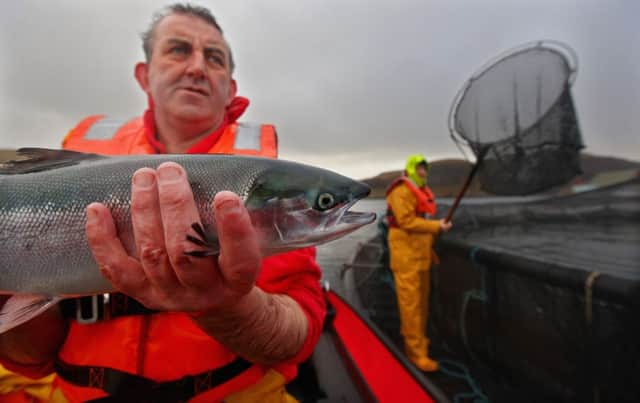Salmon farming expansion target a threat to global fish stocks


Scotland is the largest producer of farmed Atlantic salmon in the EU and one of the top three in the world –after Norway and Chile.
Figures show the industry is worth more than £1 billion a year to the Scottish economy, with salmon the country’s top food export.
Advertisement
Hide AdAdvertisement
Hide AdMore than 160,000 tonnes of farmed salmon is produced annually but ministers have announced the intention to double the quantity by 2030.
Now a new report warns that wild fish stocks and vulnerable communities could pay the price of that expansion.
Millions of tonnes of sardines, anchovies, mackerel, herring, krill and other species are caught around the world to be ground into fishmeal and fish oil, known as FMFO, for animal feed.
Estimates suggest around 460,000 tonnes of wild fish go into feeding Scottish farmed salmon each year – a similar quantity as is bought by the entire UK population.
Environmental campaign group Feedback has calculated the amount of fish caught will need to increase by two-thirds – around 310,000 tonnes – to allow the industry to double in size.
Campaigners believe the move will place severe pressure on wild fish stocks and the ocean ecosystems and human communities they support, with more than 90 per cent of global fisheries already over-fished or operating at capacity.
“The simple reality is that we cannot have our fish and eat it – feeding limited stocks of wild fish to farmed salmon is neither an efficient nor sustainable way to produce protein,” said Dr Karen Luyckx, head of research at Feedback.
“We are very concerned that despite its claim to responsible growth the industry cannot provide the transparency needed to independently verify these far-fetched claims.”
Advertisement
Hide AdAdvertisement
Hide AdJohn Aitchison, on behalf of the aquaculture sub-group of the Coastal Communities Network Scotland, said: “With so many fisheries already operating at or beyond their maximum capacity, where is all the fish meal and fish oil going to come from to feed twice as many farmed salmon, without taking fish from people’s plates in developing countries and further reducing the amount of wild fish available to other species?”
But fish farmers have defended the industry, which they say is working hard to reduce the amount of wild fish used in feed through measures such as use of plants and fish waste and trimmings from processing .
“As the salmon sector grows it is turning increasingly to other ingredients to meet the growing demand for feed, particularly plant extracts,” said a spokesman for the Scottish Salmon Producers Organisation.
“As a result of all these developments, the sector is ensuring that wild fisheries remain sustainable and the farmed sector can grow sustainably as well.”
Feedback is calling for Scottish salmon farms to publish full information about their feed supply chain, including where wild fish come from and the types used and the proportion made from by-catch or off-cuts.